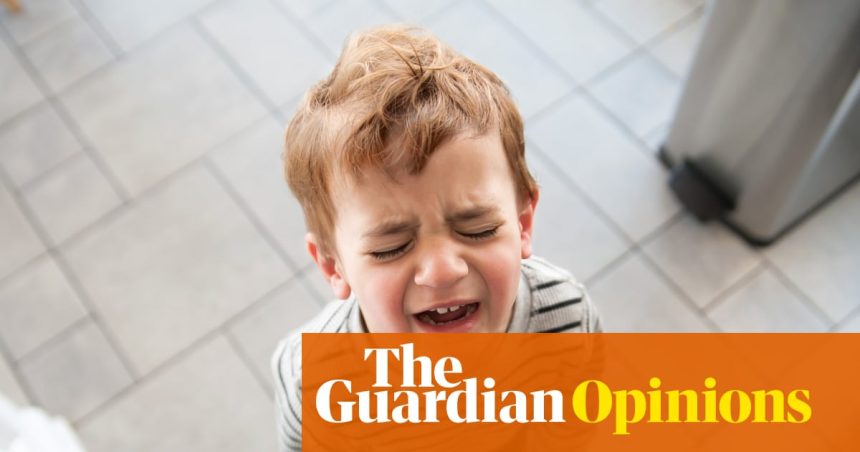There’s a song that’s been in my head all week, and no, it’s not from Taylor Swift’s new album. It’s by a far more sophisticated songwriter than Swift: Ms Rachel. The song is called Big Feelings and it goes: “Big feelings are OK / I’m here to stay with your big feelings.”
Thanks to the trend for gentle parenting, the concept of “big feelings” has become big money online, and for the most part I welcome that (Big Feelings isn’t the only song that reflects this cultural shift; the animation Small Potatoes on CBeebies has a song that goes “Feelings / I’ve got so many feelings”, which my husband likes to sing to me when I’m premenstrual). As a parent, strong emotions are hard to escape: you’re feeling them, the small child in your home is feeling them and, in one of the biggest departures for us as a species, so are myriad other children on your social media feed.
Indeed, footage of babies and children crying is so commonplace on some platforms that many parents don’t even question it. I don’t have TikTok and my Instagram algorithm is mostly fixated on soup and witchcraft, but when a colleague told me that she found the trend disturbing, not to mention morally dubious, I watched some of the videos myself.
What I found was video after video of children at their most vulnerable. Crying, shouting, screaming, and sometimes lashing out physically. I have of course been witness to these moments in my own house, but seeing someone else’s child going through it feels excruciatingly uncomfortable, especially when that child is not being comforted by their own parent. Least forgivable is a genre of video in which mothers subject their children to sinus clearing while their baby or toddler cries and screams directly to camera. It should be said that most of the videos are not like that, and yet there is still something horrible about them all.
Of course, “big feelings” aren’t always wholly traumatic. When your child is lying on the pavement distraught at the realisation that cake isn’t infinite it can be hard to keep a straight face. Many of us have been regaled with tales of particularly iconic tantrums of our own. Mine involved screaming “GIVE ME ALL YOUR MONEY!” in the lobby of the Institute of Contemporary Arts in central London. Playfully teasing your child about a time they had a meltdown, or laughing about it with your partner once they have gone to bed, is one thing. Filming a child in a moment of vulnerability and uploading it to the internet for all to see without their consent is a different matter altogether.
Then you have the trends that are simply unpleasant, such as one that involved shocking babies out of crying by throwing a slice of cheese at their foreheads, or cracking an egg on them. Such content seems geared towards humiliating children. In a piece for the New York Times, Amanda Hess wrote: “The eeriest part of these videos [is that] the parents are barely interacting with their kids. Instead they are relating to a mirror image of their children that they are spreading online. And they are revelling in their power over that image.”
There are video creators who would abhor this sort of content. They claim that they are filming their children at their most vulnerable not to mock them, but because they are trying to create teachable moments – “just look at how calmly and wonderfully I was able to defuse this child’s outburst using these techniques”. Some even try to stave off inevitable criticism. “This video is shared to educate and raise awareness – not for approval or opinions”, one video, posted by @babybearhealth (run by a paediatrician, apparently) reads. The message that follows is some of the most self-congratulatory horseshit I have read on the internet. “If you don’t live the life, don’t judge the moment.”
How about you don’t post the moment? I find myself thinking. Because I do judge these people. What I see, when I watch a video of a small child in distress, whether their parent is performing comfort or not, is a dereliction of duty – the duty to be present for your child. And I wonder what message it sends, where when your child starts expressing a “big feeling”, you get your phone out. What does that say to your baby about their wholly natural emotions? “Sharing real moments is part of the learning”, apparently.
As my husband and I begin touring schools for our son, it’s difficult not to reflect on how approaches to child development have changed since we were small. There is an increased understanding of the fact that “big feelings” are par for the course for small children. These days many adults try to validate those emotions and offer children a safe space in which to express themselves. Yet despite what the gentle parenting influencers claim, I don’t believe you can truly provide a safe space for your child if you are filming their moments of vulnerability and invading their privacy and dignity in the process. If I’m honest, I don’t think these people have much to teach any of us about parenting.
after newsletter promotion
There are some who will find that extreme, who would balk at the fact that in some ways I’d rather put a cheese slice on my boy’s forehead for a laugh than exploit his distress as a teachable moment for clicks. But to them I would say this: if “all behaviour is communication”, what, exactly, are these adults trying to say?

Leave a Reply